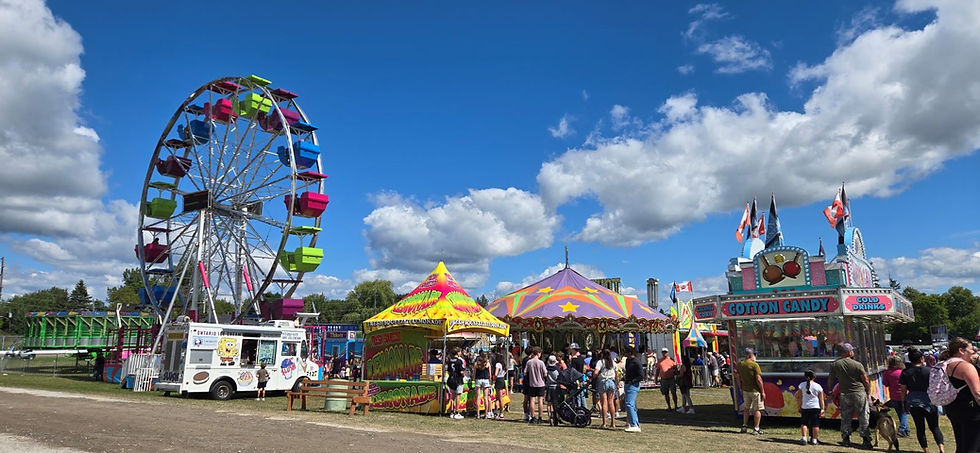Lindsay trees awarded heritage designation
- Colleen Green
- Mar 3, 2022
- 3 min read
JAMIE MORRIS, Canopy Project of Kawartha Lakes volunteer
KAWARTHA LAKES: The five sycamore trees lining Victoria Avenue, just north of Peel Street, have been given Heritage Tree status by Forests Ontario, a distinction only bestowed on about 100 trees in Southern and Central Ontario.
The trees are well known to Lindsay residents and are often remarked upon by visitors. Sycamores are Eastern North America’s largest deciduous trees. These five, 132-years old trees, dominate the skyline as you look north from Victoria Park or the farmers’ market. Their canopies arch across to the boulevard, and the mottled, patchwork appearance of the trunks make the trees instantly recognizable. The species “exfoliates” and regularly sloughs off bark.
With the approval of the City’s Parks Department, the trees were nominated by the Canopy Project Kawartha Lakes (CPKL). The CPKL is a volunteer-led community group, whose goal is to protect and enhance the urban canopy in the City of Kawartha Lakes settlement areas, for Heritage Tree status with Forests Ontario. They join roughly 100 trees from across Southern and Central Ontario, including three from our region: a bur oak which may date back 380 years, marking the head of the Fenelon Portage during fur trade days and can be seen at Maryboro Lodge, where it’s known as the “Grand Old Lady”; a 130-year-old white ash in Balsam Park; and a sugar maple near Port Perry on the ancestral lands of the Mississauga First Nations.
To be eligible, the trees had to meet criteria set by Forests Ontario. A tree could qualify as “a prominent community landmark,” as “a noble specimen because of its size, form, shape, beauty, age, colour, variety, genetic constitution, or other distinctive feature” or because of association with “a historic person.”
The sycamores qualify on all three counts. Local landmarks for sure, but also “noble specimens.” Lindsay is outside their normal hardiness zone, and sycamores don’t normally grow this far north. In a letter of support for the application Tom Mikel, coordinator of Fleming College’s Urban Forestry Program, described the trees as “incredible specimens” and the highlight on his annual Lindsay field walks with students. “For most students,” he noted, “this is the first time they may be seeing an American Sycamore (P. accidentalis) in real life, and almost certainly their first time seeing ones so massive.”
The “historic person” associated with the trees is Richard Sylvester, who planted the trees as two-year-old saplings in 1892. He and his brother operated Sylvester Manufacturing Co. The factory, which stood in the space now occupied by Tim Horton’s, Home Hardware and Lindsay Dry Cleaners, made agricultural and farm implements and employed roughly 100 residents.
Sylvester lived in the large white brick house at the corner visible to the west of the trees. His donation to the town, of the land which became Victoria Park, was a significant contribution to the community. Planting those sycamores back in 1892 was another important contribution. The final word goes to Tom Mikel: “The forethought someone had, in leaving this legacy over a century ago, is astounding.”
Are you interested in learning more about these and other notable local trees? Join the Winter Tree ID Walk, Friday, March 4th, at 11 a.m. The meeting point is the Victoria Park Gazebo, and the walk will be led by Tom Mikel and Jack Radecki (a consulting arborist and former Executive Director of the Ontario Urban Forest Council). After checking out the park’s trees, it will be on to the sycamores then other trees within easy walking distance.







무료카지노 무료카지노;
무료카지노 무료카지노;
google 优化 seo技术+jingcheng-seo.com+秒收录;
Fortune Tiger Fortune Tiger;
Fortune Tiger Fortune Tiger;
Fortune Tiger Slots Fortune…
站群/ 站群
gamesimes gamesimes;
03topgame 03topgame
EPS Machine EPS Cutting…
EPS Machine EPS and…
EPP Machine EPP Shape…
Fortune Tiger Fortune Tiger;
EPS Machine EPS and…
betwin betwin;
777 777;
slots slots;
Fortune Tiger Fortune Tiger;
google 优化 seo技术+jingcheng-seo.com+秒收录;
谷歌seo优化 谷歌SEO优化+外链发布+权重提升;
Fortune Tiger Fortune Tiger;
Fortune Tiger Fortune Tiger;
Fortune Tiger Fortune Tiger;
Fortune Tiger Slots Fortune…
gamesimes gamesimes;
站群/ 站群
03topgame 03topgame
betwin betwin;
777 777;
slots slots;
Fortune Tiger Fortune Tiger;
google seo google seo技术飞机TG-cheng716051;
03topgame 03topgame
Jogos JOGOS
Fortune Tiger Fortune Tiger;
Fortune Tiger Slots Fortune Tiger…
Fortune Tiger Fortune Tiger;
EPS машины EPS машины;
Fortune Tiger Fortune Tiger;
EPS Machine EPS Cutting Machine;
EPS Machine EPS and EPP…
EPP Machine EPP Shape Moulding…
EPS Machine EPS and EPP…
EPTU Machine ETPU Moulding Machine
EPS Machine EPS Cutting Machine;
谷歌seo推广 游戏出海seo,引流,快排,蜘蛛池租售;
Fortune Tiger Fortune Tiger;
Fortune Tiger Fortune Tiger;
Fortune Tiger Fortune Tiger;
Fortune Tiger Fortune Tiger;
Fortune Tiger Slots Fortune Tiger Slots;